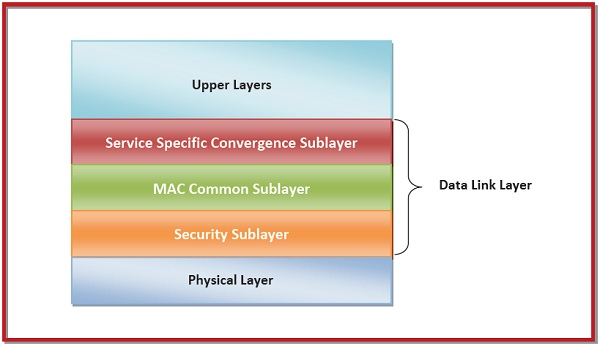
 Data Structure
Data Structure Networking
Networking RDBMS
RDBMS Operating System
Operating System Java
Java MS Excel
MS Excel iOS
iOS HTML
HTML CSS
CSS Android
Android Python
Python C Programming
C Programming C++
C++ C#
C# MongoDB
MongoDB MySQL
MySQL Javascript
Javascript PHP
PHPPhysics
Chemistry
Biology
Mathematics
English
Economics
Psychology
Social Studies
Fashion Studies
Legal Studies
- Selected Reading
- UPSC IAS Exams Notes
- Developer's Best Practices
- Questions and Answers
- Effective Resume Writing
- HR Interview Questions
- Computer Glossary
- Who is Who
The 802.16 MAC Sublayer Protocol
The IEEE 802.16 is a set of standards defining the specifications for wireless broadband technology. It has been commercialized as Worldwide Interoperability for Microwave Access (WiMAX) that is responsible for the delivery of last-mile wireless broadband access. It lays down the standards for both physical layer as well as medium access control (MAC) layer for WiMAX.
The IEEE 802.16 MAC sublayer is a part of the data link layer. The data link layer of WiMAX is divided into three sublayers as follows −
Security sublayer − This is the bottommost layer and is concerned with the security and privacy of the wireless network. It deals with encryption, decryption, and key management.
MAC common sublayer − The MAC sublayer is concerned with channel management and so is the most important sublayer. (We will study this layer in details).
Service-specific convergence sublayer − This is equivalent to a logical link control layer of other systems. It provides the required services and interface to the network layer.

MAC Common Sublayer
The IEEE 802.16 MAC has been designed for connection-oriented channel management for point-to-multipoint (PMP) broadband services. This implies that one base station is connected to multiple subscriber stations. The base station controls the system. It schedules the channels from the base station to the subscriber (downlink channels) and also manages the channels from the subscriber to the base station (uplink channels).
The MAC layer accepts data packets called MAC service data units (MSDUs) from the upper layer. It then organizes them into MAC protocol data units (MPDUs) for transmission over the air interface. The reverse procedure is followed in case of receiving the transmissions.
A convergence sublayer is included in the versions IEEE 802.16-2004 and IEEE 802.16e-2005 of the MAC sublayer providing interfaces with a number of higher-layer protocols, like ATM TDM Voice, Ethernet, IP, etc.
MAC Sublayer Features
The main features of MAC sublayer for WiMAX are −
Support for broadcast and multicast services.
Primitives imparting high-speed handover and mobility management.
MAC layer security has privacy key management (PKM). PKM version 2 provides support for extensible authentication protocol (EAP).
Energy efficiency through three power management modes − normal, sleep, and idle.
Efficient use of spectrum through methods like header suppression, packing, and fragmentation.
Primitives for manageability.
MAC Sublayer Services
802.16 imparts four classes of MAC sublayer services −
Constant Bit Rate Service − This is intended for transmitting an uncompressed voice. Here, a scheduled amount of data is transmitted in a scheduled time. A particular bandwidth is allocated and then bursts are available for transmission.
Real-time Variable Bit Rate Service − This is intended for real-time applications like multimedia. Here, variable bandwidth is needed as per the requirements of the data transmitted. In order to allocate the variable bandwidth, the base station polls the subscriber at certain intervals to know its bandwidth requirements.
Non-real-time Variable Bit Rate Service − This is intended for non-real time heavy transmissions like the transfer of large files. Here, the base station polls the subscriber, though not at fixed intervals, and allocates large bandwidth for the transmission.
Best Effort Service − This accommodates all the services except the ones mentioned in the previous three. Here, the base station does not do any polling, Instead, the subscriber station contends with other subscribers to acquire the channel.

